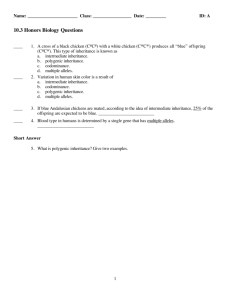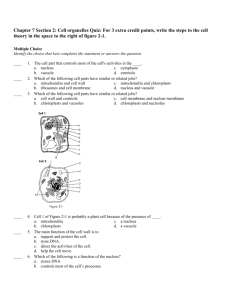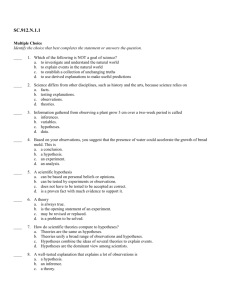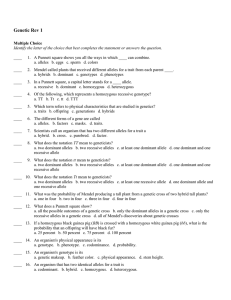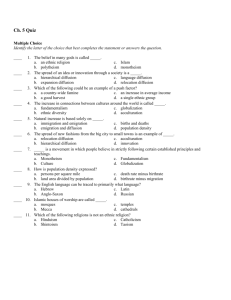Physics I Honors: Chapter 12 Practice Test: Sound
advertisement
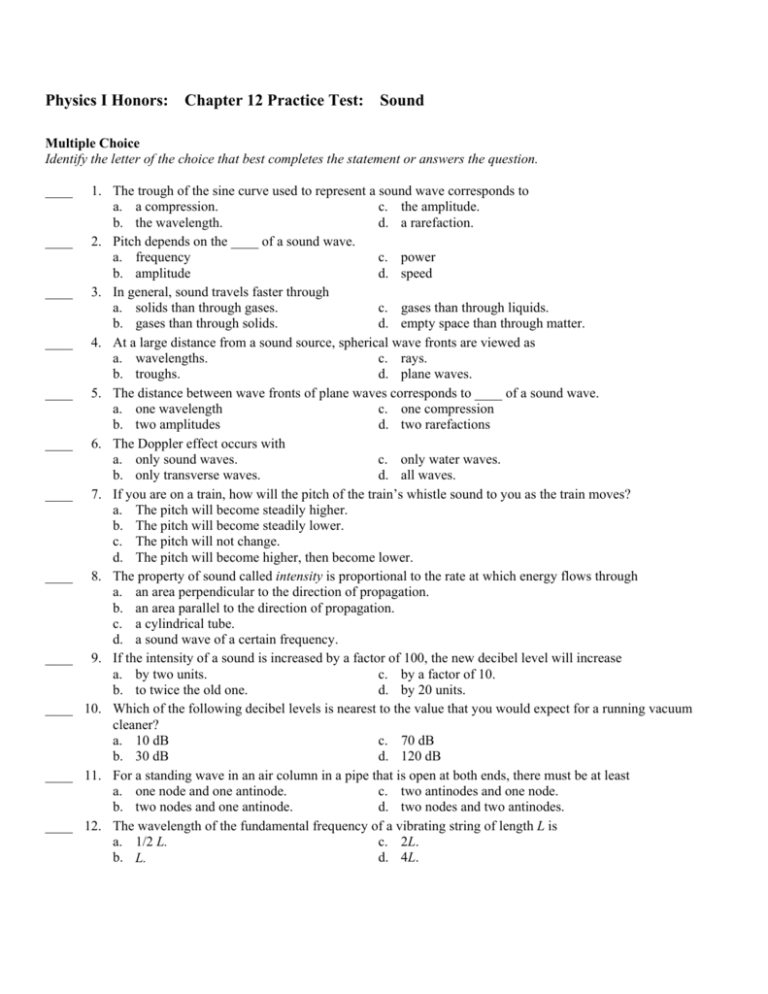
Physics I Honors: Chapter 12 Practice Test: Sound Multiple Choice Identify the letter of the choice that best completes the statement or answers the question. ____ ____ ____ ____ ____ ____ ____ ____ ____ ____ ____ ____ 1. The trough of the sine curve used to represent a sound wave corresponds to a. a compression. c. the amplitude. b. the wavelength. d. a rarefaction. 2. Pitch depends on the ____ of a sound wave. a. frequency c. power b. amplitude d. speed 3. In general, sound travels faster through a. solids than through gases. c. gases than through liquids. b. gases than through solids. d. empty space than through matter. 4. At a large distance from a sound source, spherical wave fronts are viewed as a. wavelengths. c. rays. b. troughs. d. plane waves. 5. The distance between wave fronts of plane waves corresponds to ____ of a sound wave. a. one wavelength c. one compression b. two amplitudes d. two rarefactions 6. The Doppler effect occurs with a. only sound waves. c. only water waves. b. only transverse waves. d. all waves. 7. If you are on a train, how will the pitch of the train’s whistle sound to you as the train moves? a. The pitch will become steadily higher. b. The pitch will become steadily lower. c. The pitch will not change. d. The pitch will become higher, then become lower. 8. The property of sound called intensity is proportional to the rate at which energy flows through a. an area perpendicular to the direction of propagation. b. an area parallel to the direction of propagation. c. a cylindrical tube. d. a sound wave of a certain frequency. 9. If the intensity of a sound is increased by a factor of 100, the new decibel level will increase a. by two units. c. by a factor of 10. b. to twice the old one. d. by 20 units. 10. Which of the following decibel levels is nearest to the value that you would expect for a running vacuum cleaner? a. 10 dB c. 70 dB b. 30 dB d. 120 dB 11. For a standing wave in an air column in a pipe that is open at both ends, there must be at least a. one node and one antinode. c. two antinodes and one node. b. two nodes and one antinode. d. two nodes and two antinodes. 12. The wavelength of the fundamental frequency of a vibrating string of length L is a. 1/2 L. c. 2L. b. L. d. 4L. ____ 13. The quality of a musical tone of a certain pitch results from a combination of a. fundamental frequencies. c. transverse waves. b. harmonics. d. velocities. ____ 14. How many beats per second are heard when two vibrating tuning forks having frequencies of 216 Hz and 224 Hz are held side by side? a. 6 Hz c. 9 Hz b. 8 Hz d. 3 Hz ____ 15. A vibrating guitar string emits a tone just as a 5.00 × 10 Hz tuning fork is struck. If five beats per second are heard, which of the following is a possible frequency of vibration of the string? a. 2500 Hz c. 605 Hz b. 1500 Hz d. 495 Hz ____ 16. Four beats per second are heard when two notes are sounded. The frequency of one note is 420 Hz. Which of the following is a possible frequency of the other note? a. 418 Hz c. 416 Hz b. 105 Hz d. 1680 Hz Problem 17. If the intensity of a sound is 8.0 × 10 W/m at a distance of 5.0 m, what is the power of the sound? 18. What length of guitar string would vibrate at a fundamental frequency of 825 Hz if the string is stretched so that the velocity of waves on the string is 577 m/s? 19. Closed-end organ pipes often have a movable closure that can be adjusted up or down to tune the pipe to the desired pitch. The resonant length of a certain closed-end pipe is 27.5 cm. By how many centimeters must this pipe be shortened or lengthened in order to tune it to a fundamental frequency of 349 Hz? The pipe is in an environment in which the speed of sound is 348 m/s. Physics I Honors: Chapter 12 Practice Test: Sound Answer Section MULTIPLE CHOICE 1. 2. 3. 4. 5. 6. 7. 8. 9. 10. 11. 12. 13. 14. 15. 16. ANS: ANS: ANS: ANS: ANS: ANS: ANS: ANS: ANS: ANS: ANS: ANS: ANS: ANS: ANS: ANS: D A A D A D C A D C C C B B D C DIF: DIF: DIF: DIF: DIF: DIF: DIF: DIF: DIF: DIF: DIF: DIF: DIF: DIF: DIF: DIF: I I I I II I II I IIIB II II I I IIIA IIIA IIIA OBJ: OBJ: OBJ: OBJ: OBJ: OBJ: OBJ: OBJ: OBJ: OBJ: OBJ: OBJ: OBJ: OBJ: OBJ: OBJ: PROBLEM 17. ANS: 0.25 W Given Intensity = 8.0 r = 5.0 m W/m Solution Intensity = P= DIF: IIIB 18. ANS: 0.350 m Given Solution ;P= (8.0 (Intensity) W/m ) = 0.25 W OBJ: 12-2.1 12-1.1 12-1.2 12-1.3 12-1.4 12-1.4 12-1.5 12-1.5 12-2.1 12-2.2 12-2.2 12-3.1 12-3.2 12-3.3 12-3.4 12-3.4 12-3.4 DIF: IIIB OBJ: 12-3.2 19. ANS: The resonant length must be shortened by 2.5 cm to 25.0 cm. Given v = 348 m/s f = 349 Hz L = 27.5 cm Solution L Change in length = L DIF: IIIC = 25.0 cm L= OBJ: 12-3.2




